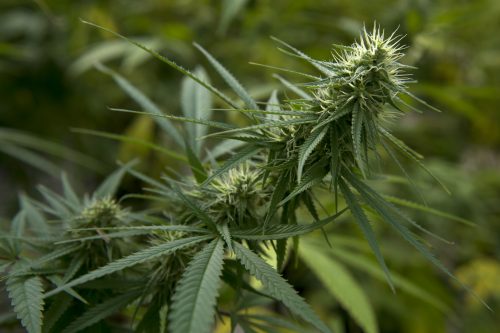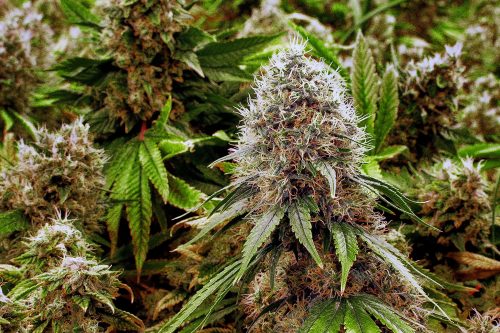A sweeping assessment on marijuana research by the National Academies of Sciences, Engineering and Medicine published Jan. 12 analyzed 10,000 studies conducted since 1999. A team of researchers for the U.S. scientific academy quantified the weight of current scientific evidence, with recommendations for future study. The report made the following conclusions about what is known about cannabis:
Conclusive evidence
Defined as: Many supportive findings from good-quality studies with no credible opposing findings. A firm conclusion can be made, and the limitations to the evidence, including chance, bias, and confounding factors, can be ruled out with reasonable confidence. Therapeutic effects: Strong evidence from randomized controlled trials to support the conclusion that cannabis/cannabinoids are an effective or ineffective treatment. Other health effects: Strong evidence from randomized controlled trials to support or refute a statistical association between cannabis/cannabinoid use and the health endpoint.
• Effective in treating chronic pain in adults
• Effective as antiemetic properties to prevent and treat chemotherapy-induced nausea and vomiting
• Effective in improving multiple sclerosis spasticity symptoms
RELATED: Get details on the 400-page report and recommendations to help further U.S. research efforts
Substantial evidence
Defined as: Several findings from good- to fair-quality studies with very few or no credible opposing findings. A general conclusion can be made, but limitations, including chance, bias, and confounding factors, cannot be ruled out with reasonable confidence. Therapeutic effects: Some evidence to support the conclusion that cannabis/cannabinoids are an effective or ineffective treatment. Other health effects: There is some evidence to support or refute a statistical association between cannabis/cannabinoid use and the health endpoint.
• Long-term cannabis smoking and worse respiratory symptoms and frequent chronic bronchitis episodes (statistical association)
• Increased risk of motor vehicle crashes (statistical association)
• Maternal cannabis smoking contributes to lower birth weight of the offspring (statistical association)
• Development of schizophrenia or other psychoses, with the highest risk among the most-frequent users (statistical association)
• Stimulant treatment of attention deficit hyperactivity disorder in adolescence is not a risk factor for problem cannabis use
• Being male and being a smoker are risk factors for cannabis use to progress to problem cannabis use
• Cannabis use at an earlier age is a risk factor for the development of problem cannabis use

Moderate evidence
Defined as: Several findings from good- to fair-quality studies with very few or no credible opposing findings. A general conclusion can be made, but limitations, including chance, bias, and confounding factors, cannot be ruled out with reasonable confidence. Therapeutic effects: Some evidence to support the conclusion that cannabis/cannabinoids are an effective or ineffective treatment. Other health effects: Some evidence to support or refute a statistical association between cannabis/cannabinoid use and the health endpoint.
• Effective in improving short-term sleep outcomes in people with sleep apnea, fibromyalgia, chronic pain and multiple sclerosis
• No statistical association between cannabis use and incidence of lung, head and neck cancers
• Improved respiratory airway dynamics among cessation from acute cannabis smokers but not chronic use (statistical association)
• Cannabis smoking leads to higher forced vital capacity (statistical association)
• Cannabis use has increased risk of overdose injuries — including respiratory distress — among pediatric population in U.S. states where cannabis is legal (statistical association)
• Acute cannabis use impairs cognitive functions such as learning, memory and attention (statistical association)
• Individuals with psychotic disorders and a history of cannabis use have better cognitive performance (statistical association)
• Cannabis use and increased symptoms of mania and hypomania in individuals with bipolar disorders (statistical association)
• Small increased risk for development of depressive disorders (statistical association)
More research news
Wrap-up: Year in weed: The five most important medical marijuana research studies of 2016
What’s the slow-down?: U.S. drug czar: The feds have dragged their feet on pot research
Split on stress: How PTSD became the most divisive medical pot issue of 2016
Weed news and interviews: Get podcasts of The Cannabist Show.
Subscribe to our newsletter here.
Watch The Cannabist Show.
Peruse our Cannabist-themed merchandise (T’s, hats, hoodies) at Cannabist Shop.
• Increased incidence of suicidal thoughts and attempts with higher incidence among heavier users (statistical association)
• Increased incidence of suicidal completion (statistical association)
• Increased incidence of social anxiety disorder (statistical association)
• No statistical association between cannabis use and worsening of negative symptoms of schizophrenia among individuals with psychotic disorders.
• Anxiety, personality disorders, bipolar disorders, ADHD are not risk factors for the development of problem cannabis use
• Individually, major depressive disorder, being male, having exposure to combined use of abused drugs are risk factors for the development of problem cannabis use
• On their own, alcohol and nicotine dependence are not risk factors for the progression of cannabis use to problem cannabis use.
• In adolesence, the frequency of cannabis use, oppositional behaviors, a younger age of first alcohol use, nicotine use, parental substance use, poor school performance, anti-social behaviors and childhood sexual behaviors are risk factors for the development of problem cannabis use.
• Persistence of problem cannabis use and history of psychiatric treatment (statistical association)
• Problem cannabis use and increased severity of post-traumatic stress disorder symptoms (statistical association)

Limited evidence
Defined as: Supportive findings from fair-quality studies, or mixed findings with most favoring one conclusion. A conclusion can be made, but there is significant uncertainty due to chance, bias, and confounding factors. Therapeutic effects: Weak evidence to support the conclusion that cannabis or cannabinoids are an effective or ineffective treatment. For other health effects: Weak evidence to support or refute a statistical association between cannabis or cannabinoid use and the health endpoint.
• Increasing appetite and decreasing weight loss associated with HIV/AIDS
• Improving clinician-measured multiple slcerosis spasticity symptoms
• THC capsules improve Tourette syndrome symptoms
• Cannabidiol improves anxiety symptoms, as assessed by public speaking test, in people with social anxiety disorders
• Improves symptoms of PTSD (nabilone, one single, small fair-quality trial)
• Better outcomes after a traumatic brain injury or intracranial hemorrhage (statistical association)
• Cannabinoids are ineffective for improving symptoms associated with dementia
• Cannabinoids are ineffective in improving intraocular pressure associated with glaucoma
• Cannabinoids are ineffective in reducing depressive symptoms in individuals with chronic pain or multiple sclerosis
• Cannabis smoking and non-seminoma-type germ cell tumors (statistical association)
• Cannabis smoking triggers acute myocardial infarction (statistical association)
• Ischemic stroke or subarachnoid hemorrhage (statistical association)
• Decreased risk of metabolic syndrome and diabetes (statistical association)
• Increased risk of pre-diabetes (statistical association)
• Occassiaonal annabis smoking and an increased risk of developing chronic obstructive pulmonary disease (statistical association)
• Decrease in the production of several inflammatory cytokines in healthy individuals(statistical association)
• No statistical association between daily cannabis use and the progression of liver fibrosis or hepatic disease in individuals with Hepatitis C
• Maternal cannabis smoking and pregnancy complications (statistical association)
• Maternal cannabis smoking and admission of the infant to the neonatal intensive care unit (statistical association)
• Impaired academic achievement and education outcomes (statistical association)
• Increased rates of unemployment or low incomes (statistical association)
• Impaired social functioning and engagement (statistical association)
• Sustained abstinence from cannabis use and impairments in learning, memory and attention (statistical association)
• Increase in schizophrenia symptoms such as hallucinations among individuals with psychotic disorders (statistical association)
• Likelihood of developing bipolar disorder, especially among regular or daily users (statistical association)
• Development of any type of anxiety disorder except social anxiety disorder (statistical association)
• Increased symptoms of anxiety among near daily users of cannabis (statistical association)
• Increased severity of PTSD symptoms (statistical association)
• Childhood anxiety and childhood depression are risk factors for the development of problem cannabis use
• Initiation of tobacco use (statistical association)
• Changes in the rates and use patterns of other licit and illicit substances (statistical association)
No or insufficient evidence to support or refute
• Effective treatment for cancers, including glioma
• Effective treatment for cancer-associated anorexia cachexia syndrome and anorexia nervosa
• Effective treatment for symptoms of irritable bowel syndrome
• Effective treatment for epilepsy
• Effective treatment for spasticity in patients with paralysis due to spinal cord injury
• Effective treatment for symptoms associated with amyotrophic lateral sclerosis
• Effective treatment for chorea and certain neuropsychiatric symptoms associated with Huntington’s disease
• Effective treatment for motor system symptoms associated with Parkinson’s disease
• Effective treatment for Dystonia
• Effective treatment for achieving abstinence in the use of addictive substances
Useful weed resources
Strain reviews: Check out our marijuana reviews organized by type — sativas and sativa-dominant hybrids, ditto with indicas.
Favorite strains: 25 ranked reviews from our marijuana critics
Follow The Cannabist on Twitter and Facebook
• Effective treatment for mental health outcomes in individuals with schizophrenia or schizophreniform psychosis
• Incidence of esophageal cancer from cannabis smoking (statistical association)
• Incidence of prostate cancer, cervical cancer, malignant gliomas, non-Hodgkin lymphoma, penile cancer, anal cancer, Kaposi’s sarcoma or bladder cancer (statistical association)
• Subsequent risk of developing acute myeloid leukemia/acute non-lympoblastic leukemia, acute lymphoblastic leukemia, rhabdomyosarcoma, astrocytoma, or neuroblastoma in offspring (statistical association)
• Increased risk of acute myocardial infarction (statistical association)
• Hospital admissions for COPD (statistical association)
• Asthma development or asthma exacerbation (statistical association)
• Other adverse immune cell responses in healthy individuals from cannabis smoking (statistical association)
• Adverse effects on immune status in individuals with HIV (statistical association)
• Increased incidence of oral human papilloma virus (statistical association)
• All-cause mortality (statistical association)
• Occupational accidents or injuries (statistical association)
• Death due to cannabis overdose (statistical association)
• Changes in the course or symptoms of depressive disorders (statistical association)
• Development of PTSD (statistical association)

Challenges and barriers in conducting cannabis and cannabinoid research
• Regulatory barriers, including the classification of cannabis as a Schedule I substance, that impede the advancement of cannabis and cannabinoid research
• Difficulty for researchers to gain access to the quantity, quality and type of cannabis product necessary to address specific research questions on the health effects
• Lack of a diverse network of funders to support research that explores the beneficial and harmful effects of cannabis use.
• Lack of conclusive evidence for the effects of cannabis use on short- and long-term health outcomes, improvements and standardization in research methodology.
